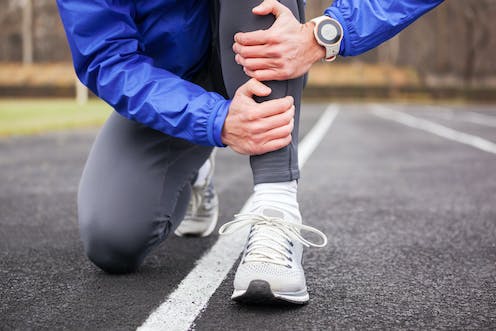
So you’re out for a leisurely jog and everything is going great – until you start to feel pain. That distinctive, shooting pain, up your shin. Even when you stop running, every time you put weight on your foot soreness shoots up your lower leg. There’s little doubt: you’ve got shin splints.
Shin splints is the term commonly used to describe what’s actually known as medial tibial stress syndrome. The injury is characterised by a diffuse pain along the inside of the shin bone (tibia) that’s aggravated by activity.
It’s thought that between 9% and 20% of runners will suffer from shin splints at some point in their life – though novice runners are almost twice as likely to suffer from injury compared to more experienced runners. Fortunately, there are many things you can do to lower your risk of this pesky injury – and prevent it from happening again.
Why shin splints happen
There are a number of risk factors that increase your likelihood of developing shin splints. Some of these we can control and make changes to prevent, others we can’t.
For example, sharp increases in the amount of running you do and how often, or adding in high impact exercises, such as jumping, makes shin splints (and other injuries) more likely. Adjusting the amount of running or the types of exercise you do can very easily lower your risk.
Being overweight or obese may also increase your likelihood of shin splints. It’s thought excess weight places greater demand on the body’s joints and muscles when exercising. As such, losing weight may help lower the risk of shin splints somewhat.
But other risk factors aren’t so easily adjusted. For instance, being a woman actually increases your risk of shin splints compared to men by as much as 71% – though it’s unclear why.
People who have low arches or “flat feet” also have a greater likelihood of shin splints, as do people whose hips tend to rotate outwards excessively.
Not to mention previous running injuries – whether that’s shin splints or other common injuries, such as plantar fasciitis – makes you twice as likely to suffer from subsequent instances of shin splints.
Whether or not you’re at a higher risk of developing shin splints, there are many things you can do to prevent them happening. Here’s how:
1. Progress gradually
When running, track your distance, your run time and the terrain you encounter. Having an idea of your running “load” will make it easier for you to increase your training more gradually and avoid shin splints.
2. Take time to recover
Prioritise adequate sleep, good hydration, a nutritious diet and ensure you have rest days spread throughout the week. Allowing the body to recover between running sessions is essential for reducing the risk of injury.
3. Build strength
Regular strength training will help reduce your risk of injury. This is because strength training helps improve the tolerance of the muscles, tendons and bones to the demands of running.

Ground Picture/ Shutterstock
Recovering properly
If you suspect you might currently be suffering with shin splints, the right care early on is important for recovery.
First, you need to determine whether your pain is indeed caused by shin splints. Shin splints will cause pain on the inside of the shin bone (tibia) which usually worsens with running or jumping. You may also find your pain resides when you’re resting or even during your normal, daily activities.
An important factor is determining the source of pain. With shin splints, it’s difficult to determine the exact source, as the whole shin tends to hurt. If your pain is pinpoint, there’s a chance you may have a different injury – such as a stress fracture.
If you aren’t certain what the injury is, it’s best to seek medical advice to ensure you’re getting the right treatment. But if you’re certain it’s shin splints, be sure to:
1. Use ice or cold water
Using an ice pack or running your leg under cold water just after exercise will help you to manage the pain associated with shin splints. It’s recommended you do this for around 10-15 minutes every two hours for as long as pain lasts.
2. Ease off the running
Cycling, elliptical training, swimming and rowing are all great alternatives to keep active while also allowing the injury to recover as these may not cause you pain like running does. Some people may be able to continue running but at a slower pace or for shorter distances. But if you do decide to run, keep an eye on your pain levels and don’t push yourself.
3. Take it slow
When you feel able to return to running, it’s important to gradually increase the amount of running you do. This will help you avoid re-injuring yourself.
4. Tape up your leg
Using kinesiology tape (an elastic, adhesive tape) on your injured leg may provide pain relief and support the injured area during activity.
If your injury is particularly bad, you might want to consider visiting a physiotherapist who can give you a personalised rehab plan, or may recommend specialised therapies that may improve recovery.
While shin splints are frustrating, it’s extremely important to be patient. Research suggests it takes around eight weeks on average for shin splints to go away (though this can vary). If you don’t take the time to recover initially, it may make your injury worse.
![]()
Nathan Liddle ne travaille pas, ne conseille pas, ne possède pas de parts, ne reçoit pas de fonds d’une organisation qui pourrait tirer profit de cet article, et n’a déclaré aucune autre affiliation que son organisme de recherche.
























